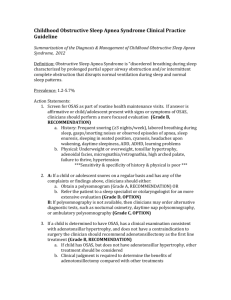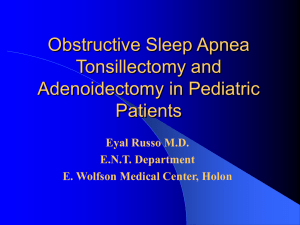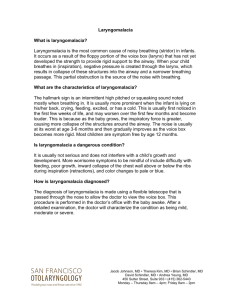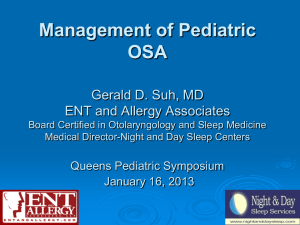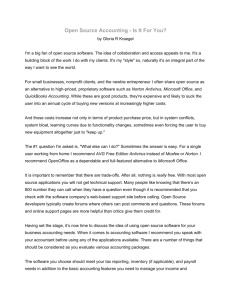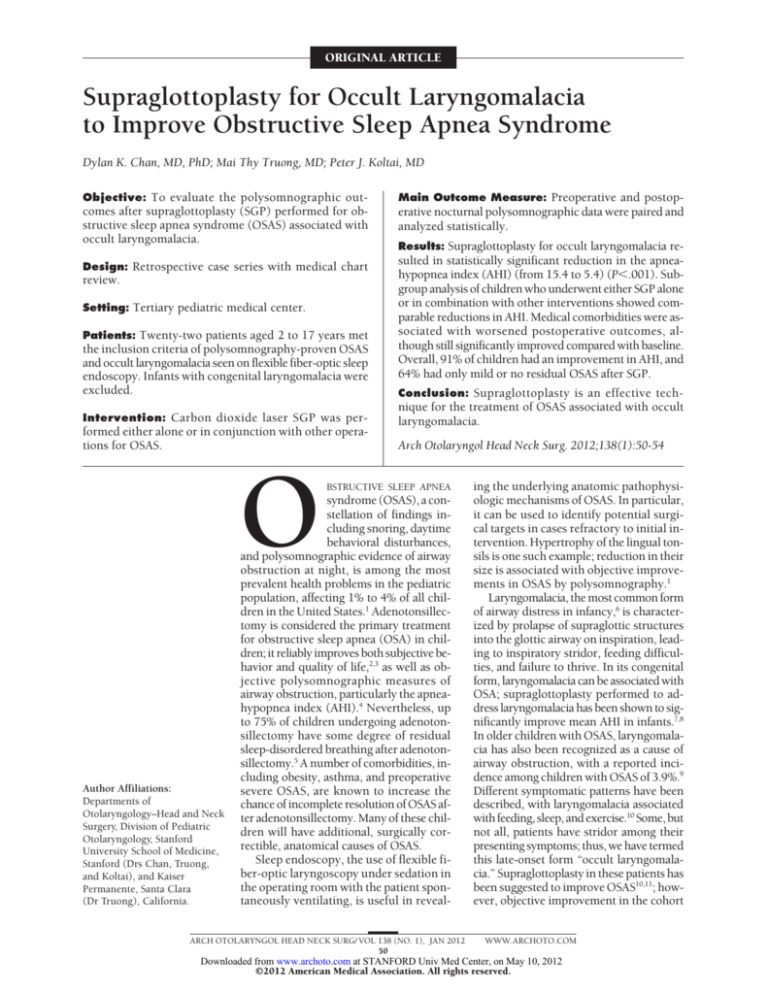
ORIGINAL ARTICLE
Supraglottoplasty for Occult Laryngomalacia
to Improve Obstructive Sleep Apnea Syndrome
Dylan K. Chan, MD, PhD; Mai Thy Truong, MD; Peter J. Koltai, MD
Objective: To evaluate the polysomnographic out-
comes after supraglottoplasty (SGP) performed for obstructive sleep apnea syndrome (OSAS) associated with
occult laryngomalacia.
Design: Retrospective case series with medical chart
review.
Setting: Tertiary pediatric medical center.
Patients: Twenty-two patients aged 2 to 17 years met
the inclusion criteria of polysomnography-proven OSAS
and occult laryngomalacia seen on flexible fiber-optic sleep
endoscopy. Infants with congenital laryngomalacia were
excluded.
Intervention: Carbon dioxide laser SGP was performed either alone or in conjunction with other operations for OSAS.
O
Author Affiliations:
Departments of
Otolaryngology–Head and Neck
Surgery, Division of Pediatric
Otolaryngology, Stanford
University School of Medicine,
Stanford (Drs Chan, Truong,
and Koltai), and Kaiser
Permanente, Santa Clara
(Dr Truong), California.
Main Outcome Measure: Preoperative and postoperative nocturnal polysomnographic data were paired and
analyzed statistically.
Results: Supraglottoplasty for occult laryngomalacia re-
sulted in statistically significant reduction in the apneahypopnea index (AHI) (from 15.4 to 5.4) (P⬍.001). Subgroup analysis of children who underwent either SGP alone
or in combination with other interventions showed comparable reductions in AHI. Medical comorbidities were associated with worsened postoperative outcomes, although still significantly improved compared with baseline.
Overall, 91% of children had an improvement in AHI, and
64% had only mild or no residual OSAS after SGP.
Conclusion: Supraglottoplasty is an effective technique for the treatment of OSAS associated with occult
laryngomalacia.
Arch Otolaryngol Head Neck Surg. 2012;138(1):50-54
BSTRUCTIVE SLEEP APNEA
syndrome (OSAS), a constellation of findings including snoring, daytime
behavioral disturbances,
and polysomnographic evidence of airway
obstruction at night, is among the most
prevalent health problems in the pediatric
population, affecting 1% to 4% of all children in the United States.1 Adenotonsillectomy is considered the primary treatment
for obstructive sleep apnea (OSA) in children; it reliably improves both subjective behavior and quality of life,2,3 as well as objective polysomnographic measures of
airway obstruction, particularly the apneahypopnea index (AHI).4 Nevertheless, up
to 75% of children undergoing adenotonsillectomy have some degree of residual
sleep-disordered breathing after adenotonsillectomy.5 A number of comorbidities, including obesity, asthma, and preoperative
severe OSAS, are known to increase the
chance of incomplete resolution of OSAS after adenotonsillectomy. Many of these children will have additional, surgically correctible, anatomical causes of OSAS.
Sleep endoscopy, the use of flexible fiber-optic laryngoscopy under sedation in
the operating room with the patient spontaneously ventilating, is useful in reveal-
ARCH OTOLARYNGOL HEAD NECK SURG/ VOL 138 (NO. 1), JAN 2012
50
ing the underlying anatomic pathophysiologic mechanisms of OSAS. In particular,
it can be used to identify potential surgical targets in cases refractory to initial intervention. Hypertrophy of the lingual tonsils is one such example; reduction in their
size is associated with objective improvements in OSAS by polysomnography.1
Laryngomalacia, the most common form
of airway distress in infancy,6 is characterized by prolapse of supraglottic structures
into the glottic airway on inspiration, leading to inspiratory stridor, feeding difficulties, and failure to thrive. In its congenital
form, laryngomalacia can be associated with
OSA; supraglottoplasty performed to address laryngomalacia has been shown to significantly improve mean AHI in infants.7,8
In older children with OSAS, laryngomalacia has also been recognized as a cause of
airway obstruction, with a reported incidence among children with OSAS of 3.9%.9
Different symptomatic patterns have been
described, with laryngomalacia associated
with feeding, sleep, and exercise.10 Some, but
not all, patients have stridor among their
presenting symptoms; thus, we have termed
this late-onset form “occult laryngomalacia.” Supraglottoplasty in these patients has
been suggested to improve OSAS10,11; however, objective improvement in the cohort
WWW.ARCHOTO.COM
Downloaded from www.archoto.com at STANFORD Univ Med Center, on May 10, 2012
©2012 American Medical Association. All rights reserved.
of patients with sleep-disordered breathing has not been
demonstrated by polysomnography.
In this study, a group of 22 children with PSGproven OSAS was identified by sleep endoscopy to have
occult laryngomalacia subsequently treated with supraglottoplasty. All patients underwent preoperative and postoperative polysomnograms, which objectively demonstrate the efficacy of this procedure. These findings suggest
that laryngomalacia should be considered together with
hypertrophy of the turbinates, adenoids, palatine tonsil,
and lingual tonsils in the constellation of anatomic, surgically correctable causes of OSAS in children.
METHODS
PATIENT SELECTION
This study was approved by the institutional review board of the
Lucile Packard Children’s Hospital (LPCH) (Palo Alto, California) and was conducted in compliance with the Healthcare Information Portability and Accountability Act. All patients who
had undergone supraglottoplasty performed by the senior author (P.J.K.) over a 6-year period (2005-2011) at LPCH were identified by CPT code search of the electronic medical record for microdirect laryngoscopy (31 526) with epiglottidectomy (31 420)
or excision (31 541). Individual medical charts thus identified were
examined. Inclusion criteria were the following:
1. The presence of an operative note documenting laryngomalacia as dynamic collapse of the arytenoids into the glottis on inspiration during sleep endoscopy
2. The presence of an operative note indicating the performance of a supraglottoplasty
3. Age of 2 to 18 years
4. The presence of presupraglottoplasty polysomnogram indicating OSAS
5. The presence of a postsupraglottoplasty polysomnogram
These criteria yielded a patient population with OSAS and concurrent laryngomalacia, excluding any infants with congenital
laryngomalacia. We refer to this population as having “occult laryngomalacia” as a cause of their OSAS, because they did not typically display symptoms usually associated with laryngomalacia,
that is, inspiratory stridor, feeding difficulty, or failure to thrive.
Occult laryngomalacia, instead, presents with snoring and OSAS.
Patients thus defined were separated into 2 groups. In the
first, patients were determined on sleep endoscopy and clinical examination to have multiple levels of obstruction, including adenotonsillar hypertrophy, lingual tonsil hypertrophy, or
inferior turbinate hypertrophy as well as occult laryngomalacia. These patients were treated with initial surgical interventions (tonsillectomy and adenoidectomy, lingual tonsillectomy, and inferior turbinate reduction, respectively) as
appropriate in a staged manner prior to supraglottoplasty. Formal assessment of OSA with polysomnography was only undertaken before and after this set of staged procedures. In the
second group, supraglottoplasty was the only surgical intervention for OSAS, with polysomnography performed before and
after the supraglottoplasty, with no other interval surgical procedures. These patients included both children who had prior
surgery (most often tonsillectomy and adenoidectomy) and presented with persistent OSAS, as well as children who did not
have any other anatomical causes of OSAS and were treated with
supraglottoplasty alone.
Because obesity and tonsillar hypertrophy are well known
to be associated with OSA, they were quantified for this population. Body mass index (BMI), calculated as weight in kilograms
divided by height in meters squared, was calculated, and patients
were classified as underweight (⬍5th percentile for BMI), normal (5th-85th percentile), overweight (85th to 95th percentile),
or obese (⬎95th percentile). Palatine tonsil size was graded as 0
(surgically absent), 1⫹ (present but not extending beyond the pillars), 2⫹ (extending beyond the pillars but filling less than 50%
of the distance between them), 3⫹ (filling more than 50% of the
distance between the pillars), and 4⫹ (touching in midline).
OPERATIVE TECHNIQUE
Laryngomalacia was identified using flexible fiber-optic sleep endoscopy, which was performed in children with persistent OSA
after adenotonsillectomy, OSA with small (0 or 1⫹) tonsils, or OSA
complicated by other medical comorbidities. Supraglottoplasty
was performed in all children under spontaneous ventilation with
total intravenous anesthesia with remifentanyl and propofol. Patients were placed in suspension with a Lindholm laryngoscope
inserted into the vallecula. Vocal cords were anesthetized with topical plain 1% lidocaine hydrochloride, and the procedure was performed under binocular microscopy. Using the microscopemounted carbon dioxide laser, the aryepiglottic folds were divided
and redundant mucosa excised from the accessory cartilages, taking care not to demucosalize the medial aspects of the arytenoids.
Patients were observed overnight in the pediatric intensive care
unit, given 3 doses of postoperative decadron (0.5 mg/kg) over
24 hours, and typically discharged the next day on a proton-pump
inhibitor for 1 month to prevent laryngopharyngeal reflux.
POLYSOMNOGRAPHY
Apnea-hypopnea indices and minimum oxygen saturation levels were obtained from the primary reports of polysomnograms
obtained at 2 centers—the Stanford Sleep Disorders Clinic and
the LPCH Sleep Laboratory. Both centers define an obstructive
apnea in children as any complete cessation of oronasal airflow
for 2 respiratory cycles with persistent respiratory effort. The AHI
as used in this study is defined as the number of obstructive apneasplus obstructive hypopneas per hour of sleep. OSAS was defined as absent (AHI⬍1), mild (AHI, 1-5), moderate (AHI, 5-10),
or severe (AHI⬎10). The minimum oxygen desaturation during an obstructive event is reported as the oxygen nadir.
Polysomnograms were performed at 3 time points: (1) before any treatment for OSA, (2) after surgical intervention not
including supraglottoplasty, and (3) after supraglottoplasty.
When possible, all polysomnograms for an individual patient
were obtained from a single center; in several cases, studies from
the 2 different centers were compared.
STATISTICAL ANALYSIS
Comparisons of paired nonparametric data, including comparison of preoperative and postoperative AHI and minimum
oxygen saturations, were performed with the Wilcoxon ranksum test. Parametric data were compared with t test. P⬍.05
was considered statistically significant.
RESULTS
PATIENT DEMOGRAPHICS
Patient demographics are summarized in the Table. A total
of 22 patients met the inclusion criteria, with a mean age
of 7.4 years (range, 2.2-17.0 years) at time of supraglottoplasty. Six of 22 (27%) were female, and the mean BMI for
the entire population was 17.9 (range, 13.2-29.1). Three
ARCH OTOLARYNGOL HEAD NECK SURG/ VOL 138 (NO. 1), JAN 2012
51
WWW.ARCHOTO.COM
Downloaded from www.archoto.com at STANFORD Univ Med Center, on May 10, 2012
©2012 American Medical Association. All rights reserved.
A
Table. Patient Demographics a
All
Patients
Characteristic
Age, mean, y
Patients, No.
Sex, No.
Male
Female
BMI
Overweight or obese,
No. (%)
Comorbid conditions,
No. (%)
7.4
22
Concurrent
SGP
7.9
13
Isolated
SGP
7.1
9
16
6
17.9
6 (27)
10
3
18.3
4 (30)
6
3
16.9
2 (22)
10 (45)
8 (62)
2 (22)
Abbreviations: BMI, body mass index (calculated as weight in kilograms
divided by height in meters squared); SGP, supraglottoplasty.
a Demographics, weight, and comorbidity status are presented for all
patients, those who underwent SGP together with another procedure for
obstructive sleep apnea (concurrent SGP) and those who underwent SGP
alone (isolated SGP).
B
children were overweight (85th-95th percentiles for BMI),
3 were obese (⬎95th percentile), 2 were underweight (⬍5th
percentile), and 15 had normal BMI for age. Reflective of
the tertiary referral patterns that characterize our practice, 10 of 22 patients (45%) had significant medical comorbidities, including trisomy 21 (2 patients); cerebral palsy
(2); and Sanfilippo syndrome, Duchenne muscular dystrophy, Prader-Willi syndrome, lissencephaly, microcephaly, and neurofibromatosis type I (1 each). Palatine
tonsil size ranged from 0 to 3⫹, with all children with 2⫹
or 3⫹ tonsils having a significant comorbidity to justify the
performance of sleep endoscopy.
SURGICAL PROCEDURES
C
All 22 children underwent flexible fiber-optic sleep endoscopy, due to persistent OSAS after adenotonsillectomy (12 patients), small (1⫹) tonsils on clinical examination (5 patients), severe hypotonia due to medical
comorbidities (4 patients), or laryngomalacia noted on
clinic flexible fiber-optic examination (1 patient). Thirteen of 22 patients underwent supraglottoplasty staged
with a second operation for OSAS (adenotonsillectomy,
lingual tonsillectomy, adenoidectomy, uvulopalatopharyngoplasty, and/or inferior turbinate reduction) between polysomnographic evaluations, with a mean time
between procedures of 2.2 months (range, 0-7.2 months).
Nine of 22 patients underwent supraglottoplasty alone
between polysomnographic evaluations. Six of these children had undergone prior surgical treatment for OSAS
(adenotonsillectomy and/or inferior turbinate reduction), with a mean time between procedures of 22.5
months (range, 7.9-83.6 months). Three children underwent supraglottoplasty as a sole treatment. The mean
ages, sex distributions, BMIs, and incidence of comorbidities of the concurrent and isolated groups were not
significantly different (Table).
Intraoperative findings were consistent for supraglottic collapse on inspiration (Figure 1). The epiglottis was
typically normally shaped, yet slightly retroflexed due to
shortened aryepiglottic folds. There was invariably a con-
Figure 1. Occult laryngomalacia. A, Sleep endoscopy demonstrates posterior
displacement and curled shape of the epiglottis. B and C, Suspension
laryngoscopy demonstrates prolapse of the arytenoids into the glottis on
inspiration and opening up of the glottis during expiration, respectively.
siderable amount of redundant mucosa overlying the arytenoids that prolapsed into the glottis. In all cases, the
carbon dioxide laser was used to divide the aryepiglottic folds and ablate the redundant mucosa. All patients
tolerated the procedure well, with no major complications encountered or surgical revisions required.
ARCH OTOLARYNGOL HEAD NECK SURG/ VOL 138 (NO. 1), JAN 2012
52
WWW.ARCHOTO.COM
Downloaded from www.archoto.com at STANFORD Univ Med Center, on May 10, 2012
©2012 American Medical Association. All rights reserved.
A
Pre-SGP
Post-SGP
20
A
B
Comorbidity
No comorbidity
20
10
B
Severe (AHI >10)
Moderate (AHI 5-10)
AHI
0
AHI
AHI
20
Concurrent SGP
Isolated SGP
10
10
Mild (AHI 1-5)
Absent (AHI <1)
100
Patients, %
0
Post-SGP
Pre-SGP
Post-SGP
50
0
Pre Post
Pre Post
Pre Post
Pre Post
20 (91%)
14 (64%)
12 (92%)
07 (54%)
8 (89%)
7 (78%)
12 (86%)
09 (64%)
All patients
(n = 22)
Concurrent
SGP (n = 13)
Isolated
SGP (n = 9)
Same sleep
laboratory
(n = 14)
C
Improved AHI
Mild or no OSAS
100
Patients, %
0
Pre-SGP
50
0
All patients
(n = 22)
Concurrent SGP Isolated SGP Same sleep lab
(n = 14)
(n = 13)
(n = 9)
Figure 2. Polysomnographic evaluation before (pre) and after (post)
supraglottoplasty (SGP). Four patient populations were evaluated: (1) all
patients, (2) children who underwent SGP together with another surgical
intervention for obstructive sleep apnea syndrome (OSAS) (concurrent SGP),
(3) children who underwent SGP alone (isolated SGP), and (4) the subset of
children who had both preoperative and postoperative polysomnograms
performed at the same sleep laboratory. A, Comparison of the
apnea-hypopnea index (AHI) before (black) and after (white) SGP. *P ⬍ .01.
B, Distribution of patients with severe (black), moderate (dark gray), mild
(light gray), and absent (white) OSA before (preop) and after (postop) SGP.
C, Overall percentage of children with improved AHI (black) or either no
residual OSAS or only mild residual OSAS (white) after SGP.
POLYSOMNOGRAPHIC OUTCOMES
All children underwent polysomnography prior to supraglottoplasty. In 9 children, preoperative and postoperative polysomnograms were obtained before and after
adenotonsillectomy performed prior to supraglottoplasty. The mean AHI in this group worsened, from 7.1
to 11.5, whereas minimum oxygen saturation levels stayed
stable at 91%, demonstrating the inefficacy of adenotonsillectomy in this population.
Polysomnographic findings are summarized in
Figure 2. Taken together, the 22 children had a significant improvement in mean AHI from 15.4 (range, 1.448.4) to 5.4 (range, 0-24.7) (P⬍.001), with 20 of 22 (91%)
having some improvement in AHI and 14 of 22 (64%)
improving to either mild or no residual OSAS. There was
no change noted in minimum oxygen saturation.
Among the 13 children who underwent supraglottoplasty together with a second staged procedure, AHI also
improved significantly, from 18.8 (range, 1.4-48.4) to 7.2
(range, 0-24.7) (P⬍.001). Twelve of 13 (92%) showed
Figure 3. Subgroup analysis. Comparison of presupraglottoplasty (pre-SGP)
and postsupraglottoplasty (post-SGP) apnea-hypopnea indices (AHIs) for
patients with or without medical comorbidities (A) and for patients
undergoing other concurrent surgical interventions for OSA or SGP alone
(B). *P⬍ .05 by Mann-Whitney test.
improvement in AHI, with 7 of 13 (54%) having either
mild or no residual OSAS. As in the whole group, minimum oxygen desaturation did not change.
The 9 patients who underwent supraglottoplasty in
isolation, without additional surgery for OSAS, had similar results: mean AHI improved significantly from 10.4
(range, 3.0-28.4) to 2.9 (range, 0-8.7; P⬍ .01), without
change in minimum oxygen saturation. Eight of 9 children (89%) had improved AHI, and 7 of 9 (78%) had only
mild or no residual OSAS after surgery.
Preoperative and postoperative AHIs were not significantly different between the concurrent and isolated intervention groups (Figure 3). However, children with medically comorbid conditions, though not noted to have worse
preoperative AHI compared with children without such comorbidities, did have significantly worse postoperative AHI,
indicating that the presence of medical comorbidities diminished the efficacy of the surgical intervention.
One potential confounding variable in our cohort was
that some patients had preoperative and postoperative
polysomnography performed at different sleep laboratories. When considering only those children who had
polysomnograms at the same institution throughout their
treatment, we observed statistically indistinguishable results from those obtain for the group as a whole; AHI improved significantly from 11.6 to 5.2 (P⬍.005), and minimum oxygen desaturation did not change. Twelve of 14
(86%) showed improvement in AHI, and 9 of 14 (64%)
achieved either mild or no residual OSAS.
COMMENT
Adenotonsillar hypertrophy is the most common cause
of OSAS in children, and removal of the palatine tonsils
and adenoids is a highly effective initial treatment in these
patients. Other anatomic sources of airway obstruction
are not addressed with adenotonsillectomy and may manifest as persistent OSAS. Polysomnography is crucial in
providing objective measurement of the severity of OSAS
and is recommended by the American Academy of Pediatrics prior to adenotonsillectomy.12 Performed before surgery, it provides confirmation of disease and in-
ARCH OTOLARYNGOL HEAD NECK SURG/ VOL 138 (NO. 1), JAN 2012
53
WWW.ARCHOTO.COM
Downloaded from www.archoto.com at STANFORD Univ Med Center, on May 10, 2012
©2012 American Medical Association. All rights reserved.
tervention, is an important criterion in perioperative risk
assessment, and acts as a valuable baseline against which
to compare postoperative outcomes. When children continue to have clinical signs and symptoms after adenotonsillectomy, polysomnography becomes even more important to determine whether further, more invasive
surgical treatment is warranted.
Under such circumstances, sleep endoscopy is an important tool for identifying potentially addressable sites
of persistent obstruction, including lingual tonsillar hypertrophy13 and occult laryngomalacia. We do not routinely perform sleep endoscopy in all children referred
for OSAS; rather, we use it for children with persistent
OSAS after adenotonsillectomy, in those with small tonsillar size in whom a second airway lesion is suspected,
and in children with such significant hypotonia in whom
a comprehensive airway evaluation is warranted.
In this study, we examined the outcomes after supraglottoplasty in children with OSAS and laryngomalacia. None
of these children had the stridor, feeding difficulties, or failure to thrive characteristic of congenital infantile laryngomalacia; the noise of this disorder is snoring, and their diagnosis was only recognized on sleep endoscopy. Our intraoperative findings largely corroborated those noted
previously10,11: compared with congenital laryngomalacia,
epiglottic findings were less striking, whereas redundant,
prolapsing mucosa overlying the arytenoids was a relatively
more significant contributor to supraglottic collapse.
Similar to previous findings, 45% of the children in this
study had a medical comorbid condition involving some
component of motor delay or hypotonia.9 Congenital laryngomalacia has been associated with poor laryngeal tone14;
similar forces may be at play in occult laryngomalacia in
older children, which may explain the high prevalence of
motor disorders in children with hypotonia, in whom OSAS
is notoriously difficult to treat. Children with such comorbidities have worse outcomes in congenital laryngomalacia15; they are more likely to need revision surgery or tracheostomy. Our findings corroborate this idea; although
children with medical comorbidities had comparable preoperative AHIs, they fared more poorly after surgery, having significantly higher postoperative AHIs than children
without comorbid conditions.
In this study, children were segregated into 1 of 2 categories: those who had an additional site of potential airway obstruction identified during clinical examination
and sleep endoscopy, such as the palatine tonsils and adenoids, lingual tonsils, or inferior turbinates; and those
in whom the only significant site of obstruction was the
supraglottis, due to either prior adenotonsillectomy or
native small tonsillar size. Ninety-one percent of all children had an improvement in AHI, and 64% had only mild
or no residual OSA after surgery; outcomes were not significantly different whether or not additional procedures were performed together with supraglottoplasty.
Overall, these findings suggest that occult laryngomalacia is an important contributor to OSA and that its correction can significantly improve sleep in children.
In conclusion, we have found that an occult form of
noninfantile laryngomalacia can be a cause of OSA in children. Unlike classic infantile laryngomalacia, which presents with stridor, this form of laryngomalacia is mani-
fest by snoring during sleep. This recently recognized
lesion can be readily detected during sleep endoscopy and
safely and effectively treated with supraglottoplasty.
Submitted for Publication: June 22, 2011; final revision
received September 4, 2011; accepted October 14, 2011.
Correspondence: Dylan K. Chan, MD, PhD, Department of Otolaryngology–Head and Neck Surgery, 801
Welch Rd, Second Floor, Stanford, CA 94305 (dylan.k
.chan@gmail.com).
Author Contributions: Dr Chan had full access to all the
data in the study and takes responsibility for the integrity of the data and the accuracy of the data analysis. Study
concept and design: Chan, Truong, and Koltai. Acquisition of data: Chan. Analysis and interpretation of data: Chan.
Drafting of the manuscript: Chan. Critical revision of the
manuscript for important intellectual content: Chan, Truong,
and Koltai. Statistical analysis: Chan. Administrative, technical, and material support: Truong and Koltai. Study supervision: Koltai.
Financial Disclosure: None reported.
Previous Presentation: A preliminary abstract for this
study was presented at the American Society for Pediatric Otolaryngology Annual Meeting; May 22, 2009; Seattle,
Washington.
REFERENCES
1. Lumeng JC, Chervin RD. Epidemiology of pediatric obstructive sleep apnea. Proc
Am Thorac Soc. 2008;5(2):242-252.
2. De Serres LM, Derkay C, Sie K, et al. Impact of adenotonsillectomy on quality of
life in children with obstructive sleep disorders. Arch Otolaryngol Head Neck Surg.
2002;128(5):489-496.
3. Goldstein NA, Fatima M, Campbell TF, Rosenfeld RM. Child behavior and quality
of life before and after tonsillectomy and adenoidectomy. Arch Otolaryngol Head
Neck Surg. 2002;128(7):770-775.
4. Brietzke SE, Gallagher D. The effectiveness of tonsillectomy and adenoidectomy
in the treatment of pediatric obstructive sleep apnea/hypopnea syndrome: a
meta-analysis. Otolaryngol Head Neck Surg. 2006;134(6):979-984.
5. Bhattacharjee R, Kheirandish-Gozal L, Spruyt K, et al. Adenotonsillectomy outcomes in treatment of obstructive sleep apnea in children: a multicenter retrospective study. Am J Respir Crit Care Med. 2010;182(5):676-683.
6. Thompson DM. Laryngomalacia: factors that influence disease severity and outcomes
of management. Curr Opin Otolaryngol Head Neck Surg. 2010;18(6):564-570.
7. Zafereo ME, Taylor RJ, Pereira KD. Supraglottoplasty for laryngomalacia with
obstructive sleep apnea. Laryngoscope. 2008;118(10):1873-1877.
8. O’Connor TE, Bumbak P, Vijayasekaran S. Objective assessment of supraglottoplasty outcomes using polysomnography. Int J Pediatr Otorhinolaryngol. 2009;
73(9):1211-1216.
9. Thevasagayam M, Rodger K, Cave D, Witmans M, El-Hakim H. Prevalence of laryngomalacia in children presenting with sleep-disordered breathing. Laryngoscope.
2010;120(8):1662-1666.
10. Richter GT, Rutter MJ, deAlarcon A, Orvidas LJ, Thompson DM. Late-onset laryngomalacia: a variant of disease. Arch Otolaryngol Head Neck Surg. 2008;134
(1):75-80.
11. Revell SM, Clark WD. Late-onset laryngomalacia: a cause of pediatric obstructive sleep apnea. Int J Pediatr Otorhinolaryngol. 2011;75(2):231-238.
12. Section on Pediatric Pulmonology, Subcommittee on Obstructive Sleep Apnea
Syndrome, American Academy of Pediatrics. Clinical practice guideline: diagnosis and management of childhood obstructive sleep apnea syndrome. Pediatrics.
2002;109(4):704-712.
13. Lin AC, Koltai PJ. Persistent pediatric obstructive sleep apnea and lingual
tonsillectomy. Otolaryngol Head Neck Surg. 2009;141(1):81-85.
14. Thompson DM. Abnormal sensorimotor integrative function of the larynx in congenital laryngomalacia: a new theory of etiology. Laryngoscope. 2007;117(6, pt
2)(suppl 114):1-33.
15. Hoff SR, Schroeder JW Jr, Rastatter JC, Holinger LD. Supraglottoplasty outcomes in relation to age and comorbid conditions. Int J Pediatr Otorhinolaryngol.
2010;74(3):245-249.
ARCH OTOLARYNGOL HEAD NECK SURG/ VOL 138 (NO. 1), JAN 2012
54
WWW.ARCHOTO.COM
Downloaded from www.archoto.com at STANFORD Univ Med Center, on May 10, 2012
©2012 American Medical Association. All rights reserved.

